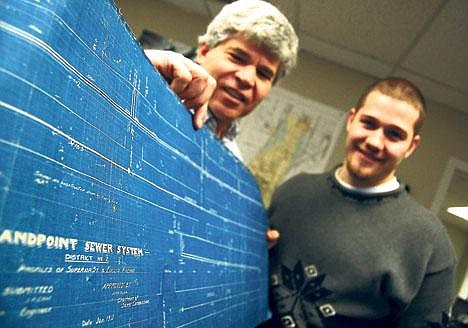Sewer fix solution sought
SANDPOINT — Local homeowners looking to sell older houses in a down market face another hurdle that could impede a sale and affect their pocketbooks: busted sewer lines.
The city and local Realtors are looking for an expedient solution to fixing private lines. One that might not slow home sales or put an additional dent in taxpayers’ wallets.
For now, the city is relying on a 2009 ordinance that puts the immediate burden on sellers and people remodeling their homes.
In an effort to upgrade sewer lines that run from a home to the city’s sewer main, the City Council adopted an ordinance last spring requiring homeowners to have their lines inspected before a sale. If the lines are faulty, homeowners must replace them. The process can cost as much as $5,000.
Ground or surface water infiltrating broken sewer lines gets funneled to the city’s sewer treatment plant often pushing capacity to the limit, said Sandpoint Public Works Director Kody Van Dyk.
“It overwhelms it at times,” Van Dyk said.
It also creates a bigger problem for the city.
“It causes us to violate our federal permit to discharge into the river,” he said.
In a city where many homes date back to the early 1900s, private sewer lines, called laterals, which run from the home’s toilets to the city’s main line, are sometimes constructed of antiquated materials that include wood, clay tile or rolled tarpaper.
Age, weather and the roots of trees are unkind to old lines, often cracking or breaking them, according to the city.
“That old clay tile has been in the ground for 100 years,” Matt Mulder, assistant city engineer, said. “The majority of those are in pretty bad shape.”
The ordinance requires sellers of homes that are older than five years, or homeowners who apply for building permits valued at more than $25,000, to have their laterals inspected.
The video inspection of the lines done by a private contractor usually costs about $250.
Fern Mikesell was told of the ordinance by a real estate agent when she put her mother’s Marion Avenue home on the market. The house was built in the 1950s and a sewer line inspection showed that the lateral was defective.
Mikesell ran into several problems before listing the older home, but repairing the failed sewer line was the most costly.
“That was a big one,” she said.
By slipping another pipe inside the old one, contractors fixed the home’s lateral in short order, she said. The fix didn’t take long, but the $5,000 price tag was a blow.
“The cost was the big thing,” she said.
Realtors let her know of the ordinance up front, so it didn’t come as a shock at the closing table.
“It would have held up the sale if we hadn’t done it ahead of time,” she said.
That hasn’t happened yet, said Raphael Barta, an associate broker at Century 21 Riverstone because local agents are apprising clients of the ordinance beforehand.
“We’re all over it,” he said.
But if listing or upgrading a home is the only incentive to repairing lines, he said, it could take decades before all the bad lines have been replaced.
“We can’t take 50 years to fix it,” he said. “We need to come up with sense of urgency.
“Who would willingly want to spend $2,500 if they don’t have to?”
The real estate community plans to meet with public works officials to find an expedient way to get faulty laterals fixed.
One solution could be to set up a fund that would help homeowners pay to inspect and repair broken pipes, with the cost added incrementally to tax rolls, Barta said. Establishing a local improvement district to raise money to fix laterals has also been suggested.
Sandpoint had 424 violations at its sewer plant between 2003 and 2007. The plant effectively treats approximately 6 million gallons of effluent daily. Because in part to broken laterals, long periods of rain or runoff can cause the plant to receive an influx of 13 million gallons per day, Van Dyk said.
Money from an $8 million sewer bond that passed in 2007 was used to upgrade city sewer mains and its wastewater treatment plant, but the laterals remain an issue, he said.
Although the federal government may negotiate with cities on sewer issues, it can impose a penalty of $35,500 per day for each violation. March 2009 was the last time the city’s plant was in violation, Van Dyk said.
The possibility of being fined for past violations hasn’t gone away, he said.
“It’s very possible that we will be fined,” he said. “I still believe that.”

